Biology Report: Exploring Inheritance in Drosophila Species Crosses
VerifiedAdded on 2023/02/01
|12
|3321
|48
Report
AI Summary
This Biology report explores the inheritance patterns in Drosophila species, commonly known as fruit flies, utilizing the principles of Mendelian genetics. The study involved analyzing the outcomes of various genetic crosses, including those with wild-type and white-eye mutations, ebony body and vestigial wing mutations, and a virtual cross with star-eyed characteristics. The methodology encompassed laboratory crosses and virtual simulations, allowing for the determination of phenotypic ratios in the F1 generation. The results were presented in tables, detailing the proportion of offspring with different traits. The discussion interprets the results, explaining the patterns of inheritance, identifying dominant and recessive alleles, and illustrating the findings with Punnett squares. The report concludes with a summary of the inheritance patterns observed in the Drosophila crosses and their adherence to Mendelian principles, providing insights into the genetic basis of the observed traits and the significance of the results.

Topic: BIOLOGY
Name of the Student:
Name of the University:
Author’s note:
Name of the Student:
Name of the University:
Author’s note:
Paraphrase This Document
Need a fresh take? Get an instant paraphrase of this document with our AI Paraphraser
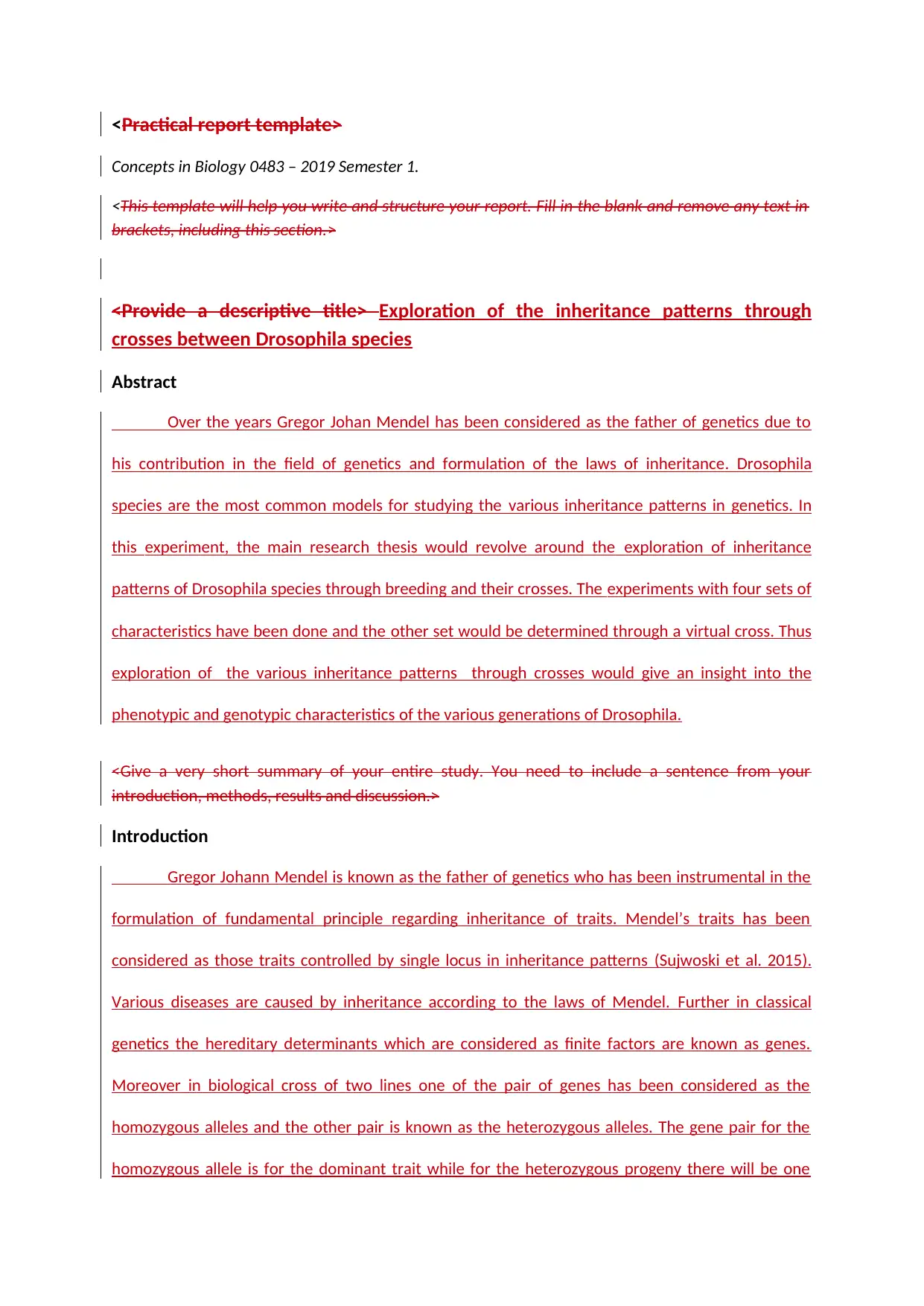
<Practical report template>
Concepts in Biology 0483 – 2019 Semester 1.
<This template will help you write and structure your report. Fill in the blank and remove any text in
brackets, including this section.>
<Provide a descriptive title> Exploration of the inheritance patterns through
crosses between Drosophila species
Abstract
Over the years Gregor Johan Mendel has been considered as the father of genetics due to
his contribution in the field of genetics and formulation of the laws of inheritance. Drosophila
species are the most common models for studying the various inheritance patterns in genetics. In
this experiment, the main research thesis would revolve around the exploration of inheritance
patterns of Drosophila species through breeding and their crosses. The experiments with four sets of
characteristics have been done and the other set would be determined through a virtual cross. Thus
exploration of the various inheritance patterns through crosses would give an insight into the
phenotypic and genotypic characteristics of the various generations of Drosophila.
<Give a very short summary of your entire study. You need to include a sentence from your
introduction, methods, results and discussion.>
Introduction
Gregor Johann Mendel is known as the father of genetics who has been instrumental in the
formulation of fundamental principle regarding inheritance of traits. Mendel’s traits has been
considered as those traits controlled by single locus in inheritance patterns (Sujwoski et al. 2015).
Various diseases are caused by inheritance according to the laws of Mendel. Further in classical
genetics the hereditary determinants which are considered as finite factors are known as genes.
Moreover in biological cross of two lines one of the pair of genes has been considered as the
homozygous alleles and the other pair is known as the heterozygous alleles. The gene pair for the
homozygous allele is for the dominant trait while for the heterozygous progeny there will be one
Concepts in Biology 0483 – 2019 Semester 1.
<This template will help you write and structure your report. Fill in the blank and remove any text in
brackets, including this section.>
<Provide a descriptive title> Exploration of the inheritance patterns through
crosses between Drosophila species
Abstract
Over the years Gregor Johan Mendel has been considered as the father of genetics due to
his contribution in the field of genetics and formulation of the laws of inheritance. Drosophila
species are the most common models for studying the various inheritance patterns in genetics. In
this experiment, the main research thesis would revolve around the exploration of inheritance
patterns of Drosophila species through breeding and their crosses. The experiments with four sets of
characteristics have been done and the other set would be determined through a virtual cross. Thus
exploration of the various inheritance patterns through crosses would give an insight into the
phenotypic and genotypic characteristics of the various generations of Drosophila.
<Give a very short summary of your entire study. You need to include a sentence from your
introduction, methods, results and discussion.>
Introduction
Gregor Johann Mendel is known as the father of genetics who has been instrumental in the
formulation of fundamental principle regarding inheritance of traits. Mendel’s traits has been
considered as those traits controlled by single locus in inheritance patterns (Sujwoski et al. 2015).
Various diseases are caused by inheritance according to the laws of Mendel. Further in classical
genetics the hereditary determinants which are considered as finite factors are known as genes.
Moreover in biological cross of two lines one of the pair of genes has been considered as the
homozygous alleles and the other pair is known as the heterozygous alleles. The gene pair for the
homozygous allele is for the dominant trait while for the heterozygous progeny there will be one
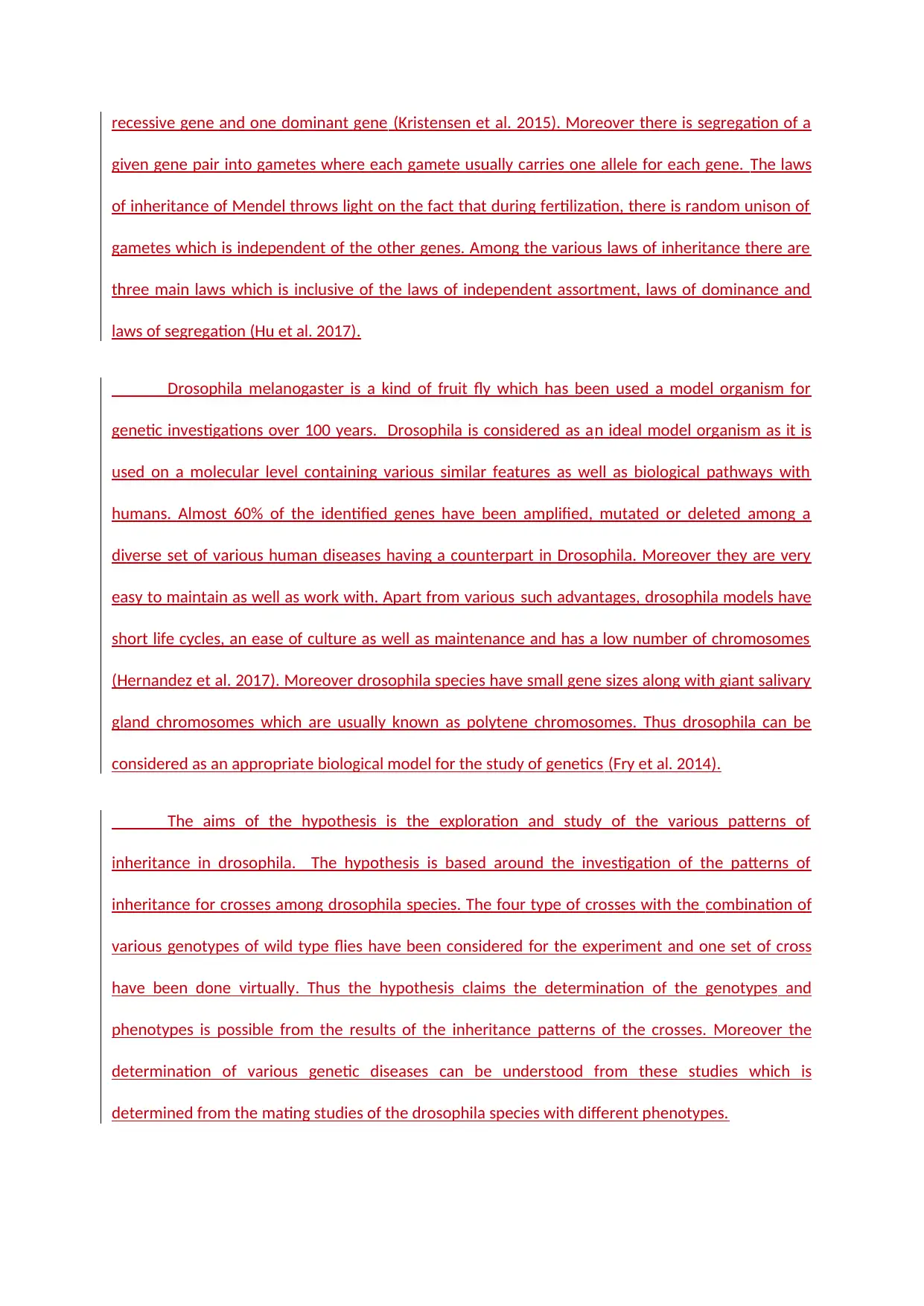
recessive gene and one dominant gene (Kristensen et al. 2015). Moreover there is segregation of a
given gene pair into gametes where each gamete usually carries one allele for each gene. The laws
of inheritance of Mendel throws light on the fact that during fertilization, there is random unison of
gametes which is independent of the other genes. Among the various laws of inheritance there are
three main laws which is inclusive of the laws of independent assortment, laws of dominance and
laws of segregation (Hu et al. 2017).
Drosophila melanogaster is a kind of fruit fly which has been used a model organism for
genetic investigations over 100 years. Drosophila is considered as an ideal model organism as it is
used on a molecular level containing various similar features as well as biological pathways with
humans. Almost 60% of the identified genes have been amplified, mutated or deleted among a
diverse set of various human diseases having a counterpart in Drosophila. Moreover they are very
easy to maintain as well as work with. Apart from various such advantages, drosophila models have
short life cycles, an ease of culture as well as maintenance and has a low number of chromosomes
(Hernandez et al. 2017). Moreover drosophila species have small gene sizes along with giant salivary
gland chromosomes which are usually known as polytene chromosomes. Thus drosophila can be
considered as an appropriate biological model for the study of genetics (Fry et al. 2014).
The aims of the hypothesis is the exploration and study of the various patterns of
inheritance in drosophila. The hypothesis is based around the investigation of the patterns of
inheritance for crosses among drosophila species. The four type of crosses with the combination of
various genotypes of wild type flies have been considered for the experiment and one set of cross
have been done virtually. Thus the hypothesis claims the determination of the genotypes and
phenotypes is possible from the results of the inheritance patterns of the crosses. Moreover the
determination of various genetic diseases can be understood from these studies which is
determined from the mating studies of the drosophila species with different phenotypes.
given gene pair into gametes where each gamete usually carries one allele for each gene. The laws
of inheritance of Mendel throws light on the fact that during fertilization, there is random unison of
gametes which is independent of the other genes. Among the various laws of inheritance there are
three main laws which is inclusive of the laws of independent assortment, laws of dominance and
laws of segregation (Hu et al. 2017).
Drosophila melanogaster is a kind of fruit fly which has been used a model organism for
genetic investigations over 100 years. Drosophila is considered as an ideal model organism as it is
used on a molecular level containing various similar features as well as biological pathways with
humans. Almost 60% of the identified genes have been amplified, mutated or deleted among a
diverse set of various human diseases having a counterpart in Drosophila. Moreover they are very
easy to maintain as well as work with. Apart from various such advantages, drosophila models have
short life cycles, an ease of culture as well as maintenance and has a low number of chromosomes
(Hernandez et al. 2017). Moreover drosophila species have small gene sizes along with giant salivary
gland chromosomes which are usually known as polytene chromosomes. Thus drosophila can be
considered as an appropriate biological model for the study of genetics (Fry et al. 2014).
The aims of the hypothesis is the exploration and study of the various patterns of
inheritance in drosophila. The hypothesis is based around the investigation of the patterns of
inheritance for crosses among drosophila species. The four type of crosses with the combination of
various genotypes of wild type flies have been considered for the experiment and one set of cross
have been done virtually. Thus the hypothesis claims the determination of the genotypes and
phenotypes is possible from the results of the inheritance patterns of the crosses. Moreover the
determination of various genetic diseases can be understood from these studies which is
determined from the mating studies of the drosophila species with different phenotypes.
⊘ This is a preview!⊘
Do you want full access?
Subscribe today to unlock all pages.

Trusted by 1+ million students worldwide
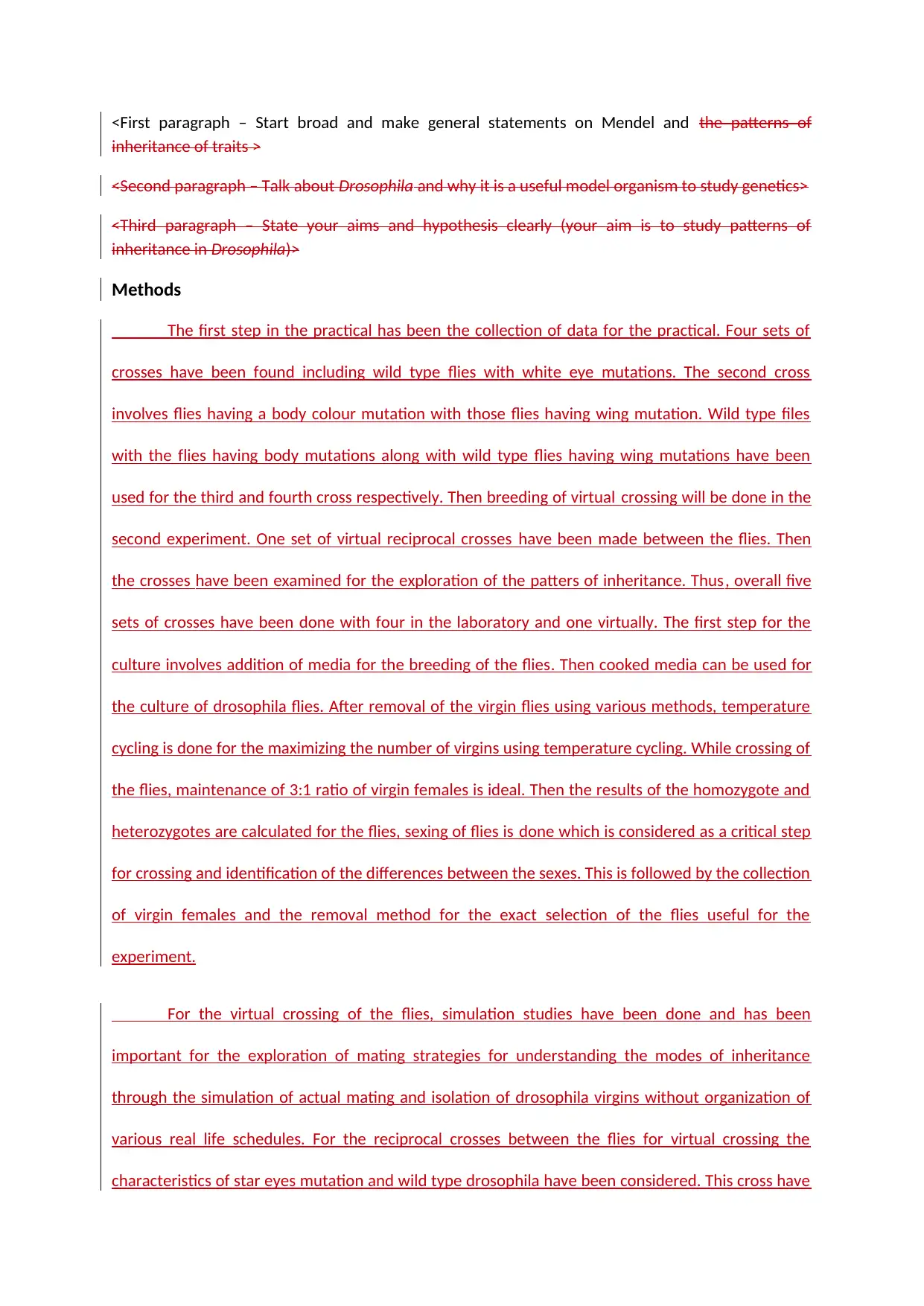
<First paragraph – Start broad and make general statements on Mendel and the patterns of
inheritance of traits >
<Second paragraph – Talk about Drosophila and why it is a useful model organism to study genetics>
<Third paragraph – State your aims and hypothesis clearly (your aim is to study patterns of
inheritance in Drosophila)>
Methods
The first step in the practical has been the collection of data for the practical. Four sets of
crosses have been found including wild type flies with white eye mutations. The second cross
involves flies having a body colour mutation with those flies having wing mutation. Wild type files
with the flies having body mutations along with wild type flies having wing mutations have been
used for the third and fourth cross respectively. Then breeding of virtual crossing will be done in the
second experiment. One set of virtual reciprocal crosses have been made between the flies. Then
the crosses have been examined for the exploration of the patters of inheritance. Thus, overall five
sets of crosses have been done with four in the laboratory and one virtually. The first step for the
culture involves addition of media for the breeding of the flies. Then cooked media can be used for
the culture of drosophila flies. After removal of the virgin flies using various methods, temperature
cycling is done for the maximizing the number of virgins using temperature cycling. While crossing of
the flies, maintenance of 3:1 ratio of virgin females is ideal. Then the results of the homozygote and
heterozygotes are calculated for the flies, sexing of flies is done which is considered as a critical step
for crossing and identification of the differences between the sexes. This is followed by the collection
of virgin females and the removal method for the exact selection of the flies useful for the
experiment.
For the virtual crossing of the flies, simulation studies have been done and has been
important for the exploration of mating strategies for understanding the modes of inheritance
through the simulation of actual mating and isolation of drosophila virgins without organization of
various real life schedules. For the reciprocal crosses between the flies for virtual crossing the
characteristics of star eyes mutation and wild type drosophila have been considered. This cross have
inheritance of traits >
<Second paragraph – Talk about Drosophila and why it is a useful model organism to study genetics>
<Third paragraph – State your aims and hypothesis clearly (your aim is to study patterns of
inheritance in Drosophila)>
Methods
The first step in the practical has been the collection of data for the practical. Four sets of
crosses have been found including wild type flies with white eye mutations. The second cross
involves flies having a body colour mutation with those flies having wing mutation. Wild type files
with the flies having body mutations along with wild type flies having wing mutations have been
used for the third and fourth cross respectively. Then breeding of virtual crossing will be done in the
second experiment. One set of virtual reciprocal crosses have been made between the flies. Then
the crosses have been examined for the exploration of the patters of inheritance. Thus, overall five
sets of crosses have been done with four in the laboratory and one virtually. The first step for the
culture involves addition of media for the breeding of the flies. Then cooked media can be used for
the culture of drosophila flies. After removal of the virgin flies using various methods, temperature
cycling is done for the maximizing the number of virgins using temperature cycling. While crossing of
the flies, maintenance of 3:1 ratio of virgin females is ideal. Then the results of the homozygote and
heterozygotes are calculated for the flies, sexing of flies is done which is considered as a critical step
for crossing and identification of the differences between the sexes. This is followed by the collection
of virgin females and the removal method for the exact selection of the flies useful for the
experiment.
For the virtual crossing of the flies, simulation studies have been done and has been
important for the exploration of mating strategies for understanding the modes of inheritance
through the simulation of actual mating and isolation of drosophila virgins without organization of
various real life schedules. For the reciprocal crosses between the flies for virtual crossing the
characteristics of star eyes mutation and wild type drosophila have been considered. This cross have
Paraphrase This Document
Need a fresh take? Get an instant paraphrase of this document with our AI Paraphraser
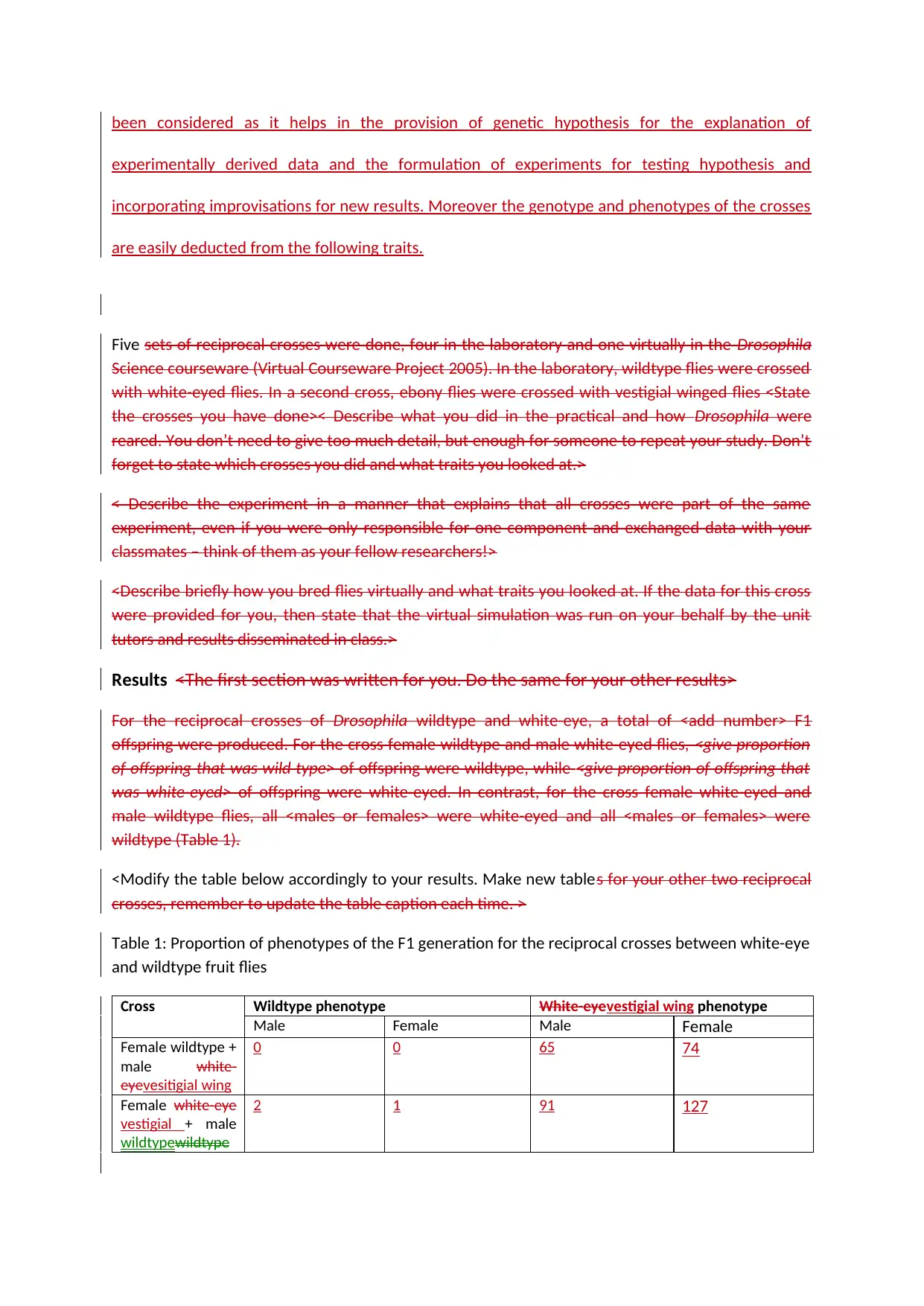
been considered as it helps in the provision of genetic hypothesis for the explanation of
experimentally derived data and the formulation of experiments for testing hypothesis and
incorporating improvisations for new results. Moreover the genotype and phenotypes of the crosses
are easily deducted from the following traits.
Five sets of reciprocal crosses were done, four in the laboratory and one virtually in the Drosophila
Science courseware (Virtual Courseware Project 2005). In the laboratory, wildtype flies were crossed
with white-eyed flies. In a second cross, ebony flies were crossed with vestigial winged flies <State
the crosses you have done>< Describe what you did in the practical and how Drosophila were
reared. You don’t need to give too much detail, but enough for someone to repeat your study. Don’t
forget to state which crosses you did and what traits you looked at.>
< Describe the experiment in a manner that explains that all crosses were part of the same
experiment, even if you were only responsible for one component and exchanged data with your
classmates – think of them as your fellow researchers!>
<Describe briefly how you bred flies virtually and what traits you looked at. If the data for this cross
were provided for you, then state that the virtual simulation was run on your behalf by the unit
tutors and results disseminated in class.>
Results <The first section was written for you. Do the same for your other results>
For the reciprocal crosses of Drosophila wildtype and white-eye, a total of <add number> F1
offspring were produced. For the cross female wildtype and male white-eyed flies, <give proportion
of offspring that was wild type> of offspring were wildtype, while <give proportion of offspring that
was white-eyed> of offspring were white-eyed. In contrast, for the cross female white-eyed and
male wildtype flies, all <males or females> were white-eyed and all <males or females> were
wildtype (Table 1).
<Modify the table below accordingly to your results. Make new tables for your other two reciprocal
crosses, remember to update the table caption each time. >
Table 1: Proportion of phenotypes of the F1 generation for the reciprocal crosses between white-eye
and wildtype fruit flies
Cross Wildtype phenotype White-eyevestigial wing phenotype
Male Female Male Female
Female wildtype +
male white-
eyevesitigial wing
0 0 65 74
Female white-eye
vestigial + male
wildtypewildtype
2 1 91 127
experimentally derived data and the formulation of experiments for testing hypothesis and
incorporating improvisations for new results. Moreover the genotype and phenotypes of the crosses
are easily deducted from the following traits.
Five sets of reciprocal crosses were done, four in the laboratory and one virtually in the Drosophila
Science courseware (Virtual Courseware Project 2005). In the laboratory, wildtype flies were crossed
with white-eyed flies. In a second cross, ebony flies were crossed with vestigial winged flies <State
the crosses you have done>< Describe what you did in the practical and how Drosophila were
reared. You don’t need to give too much detail, but enough for someone to repeat your study. Don’t
forget to state which crosses you did and what traits you looked at.>
< Describe the experiment in a manner that explains that all crosses were part of the same
experiment, even if you were only responsible for one component and exchanged data with your
classmates – think of them as your fellow researchers!>
<Describe briefly how you bred flies virtually and what traits you looked at. If the data for this cross
were provided for you, then state that the virtual simulation was run on your behalf by the unit
tutors and results disseminated in class.>
Results <The first section was written for you. Do the same for your other results>
For the reciprocal crosses of Drosophila wildtype and white-eye, a total of <add number> F1
offspring were produced. For the cross female wildtype and male white-eyed flies, <give proportion
of offspring that was wild type> of offspring were wildtype, while <give proportion of offspring that
was white-eyed> of offspring were white-eyed. In contrast, for the cross female white-eyed and
male wildtype flies, all <males or females> were white-eyed and all <males or females> were
wildtype (Table 1).
<Modify the table below accordingly to your results. Make new tables for your other two reciprocal
crosses, remember to update the table caption each time. >
Table 1: Proportion of phenotypes of the F1 generation for the reciprocal crosses between white-eye
and wildtype fruit flies
Cross Wildtype phenotype White-eyevestigial wing phenotype
Male Female Male Female
Female wildtype +
male white-
eyevesitigial wing
0 0 65 74
Female white-eye
vestigial + male
wildtypewildtype
2 1 91 127
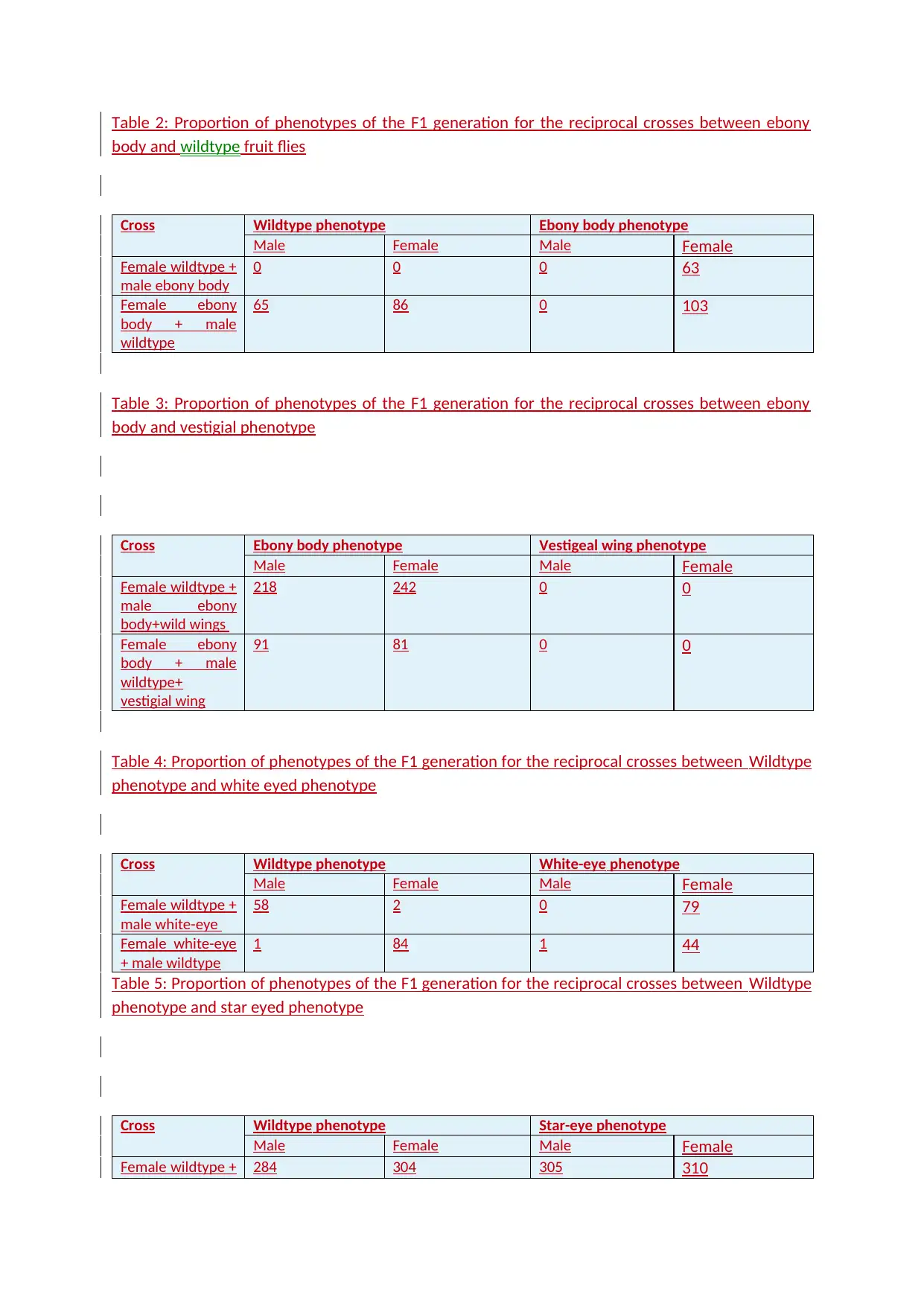
Table 2: Proportion of phenotypes of the F1 generation for the reciprocal crosses between ebony
body and wildtype fruit flies
Cross Wildtype phenotype Ebony body phenotype
Male Female Male Female
Female wildtype +
male ebony body
0 0 0 63
Female ebony
body + male
wildtype
65 86 0 103
Table 3: Proportion of phenotypes of the F1 generation for the reciprocal crosses between ebony
body and vestigial phenotype
Cross Ebony body phenotype Vestigeal wing phenotype
Male Female Male Female
Female wildtype +
male ebony
body+wild wings
218 242 0 0
Female ebony
body + male
wildtype+
vestigial wing
91 81 0 0
Table 4: Proportion of phenotypes of the F1 generation for the reciprocal crosses between Wildtype
phenotype and white eyed phenotype
Cross Wildtype phenotype White-eye phenotype
Male Female Male Female
Female wildtype +
male white-eye
58 2 0 79
Female white-eye
+ male wildtype
1 84 1 44
Table 5: Proportion of phenotypes of the F1 generation for the reciprocal crosses between Wildtype
phenotype and star eyed phenotype
Cross Wildtype phenotype Star-eye phenotype
Male Female Male Female
Female wildtype + 284 304 305 310
body and wildtype fruit flies
Cross Wildtype phenotype Ebony body phenotype
Male Female Male Female
Female wildtype +
male ebony body
0 0 0 63
Female ebony
body + male
wildtype
65 86 0 103
Table 3: Proportion of phenotypes of the F1 generation for the reciprocal crosses between ebony
body and vestigial phenotype
Cross Ebony body phenotype Vestigeal wing phenotype
Male Female Male Female
Female wildtype +
male ebony
body+wild wings
218 242 0 0
Female ebony
body + male
wildtype+
vestigial wing
91 81 0 0
Table 4: Proportion of phenotypes of the F1 generation for the reciprocal crosses between Wildtype
phenotype and white eyed phenotype
Cross Wildtype phenotype White-eye phenotype
Male Female Male Female
Female wildtype +
male white-eye
58 2 0 79
Female white-eye
+ male wildtype
1 84 1 44
Table 5: Proportion of phenotypes of the F1 generation for the reciprocal crosses between Wildtype
phenotype and star eyed phenotype
Cross Wildtype phenotype Star-eye phenotype
Male Female Male Female
Female wildtype + 284 304 305 310
⊘ This is a preview!⊘
Do you want full access?
Subscribe today to unlock all pages.

Trusted by 1+ million students worldwide

male star-eye
Female white-eye
+ male wildtype
294 279 294 306
Female white-eye
+ male wildtype
294 279 294 306
Paraphrase This Document
Need a fresh take? Get an instant paraphrase of this document with our AI Paraphraser

Discussion
< Interpret and explain your result: What did you find? Explain the pattern of inheritance for each
trait. Are the traits following Mendel’s rules? If not, are they located on the autosomes or sex
chromosome? Which is the dominant allele and recessive allele? Use Punnett squares to illustrate
your point. How significant are your results? Have other people found similar results? >
< Explain limitations to your experiment>
< Conclusion statement –summarise the conclusions that can be drawn from your work >
The interpretations from the crosses of Drosophila species highlights the phenotype as well as
genotypes of the F1 progenies. Four kinds of crosses have been done highlighting the various
phenotypes and the possible number of progenies resulting from the mating studies. The fifth cross
involves a virtual one where the characteristic of star eyed individuals have been considered. For an
allele to be recessive the presence of both the copies from each of the parent is important. Parents
having one recessive and one dominant allele would be considered as the dominant type. Thus the
determination of the dominant and the recessive alleles can be understood from the mating studies
of the drosophila species.
In the first cross between wild type males and females and the characteristic of vestigial wings have
been taken. Wild type flies has shown the maximum number of 65, 74, 91,127 respectively. Thus
from the crosses it can be understood that the wild type is dominant over the vestigial wing as the
number of progenies in the crosses are less than the wild type . The dominance of the wild type
phenotype over the vestigial one is a result of masking of the recessive alleles thus following
Mendel’s inheritance with the homozygous and recessive alleles. The determination as well as
differentiation of the recessive and dominant alleles have been done.
X X
Xv XVX XVX
Y XY XY
XV X
X XVX XX
Y XVY XY
Fig 1: The first punette square is between wildtype female and the vestigeal wing female while the
second punette square is between wild type males and vestigial females.
< Interpret and explain your result: What did you find? Explain the pattern of inheritance for each
trait. Are the traits following Mendel’s rules? If not, are they located on the autosomes or sex
chromosome? Which is the dominant allele and recessive allele? Use Punnett squares to illustrate
your point. How significant are your results? Have other people found similar results? >
< Explain limitations to your experiment>
< Conclusion statement –summarise the conclusions that can be drawn from your work >
The interpretations from the crosses of Drosophila species highlights the phenotype as well as
genotypes of the F1 progenies. Four kinds of crosses have been done highlighting the various
phenotypes and the possible number of progenies resulting from the mating studies. The fifth cross
involves a virtual one where the characteristic of star eyed individuals have been considered. For an
allele to be recessive the presence of both the copies from each of the parent is important. Parents
having one recessive and one dominant allele would be considered as the dominant type. Thus the
determination of the dominant and the recessive alleles can be understood from the mating studies
of the drosophila species.
In the first cross between wild type males and females and the characteristic of vestigial wings have
been taken. Wild type flies has shown the maximum number of 65, 74, 91,127 respectively. Thus
from the crosses it can be understood that the wild type is dominant over the vestigial wing as the
number of progenies in the crosses are less than the wild type . The dominance of the wild type
phenotype over the vestigial one is a result of masking of the recessive alleles thus following
Mendel’s inheritance with the homozygous and recessive alleles. The determination as well as
differentiation of the recessive and dominant alleles have been done.
X X
Xv XVX XVX
Y XY XY
XV X
X XVX XX
Y XVY XY
Fig 1: The first punette square is between wildtype female and the vestigeal wing female while the
second punette square is between wild type males and vestigial females.
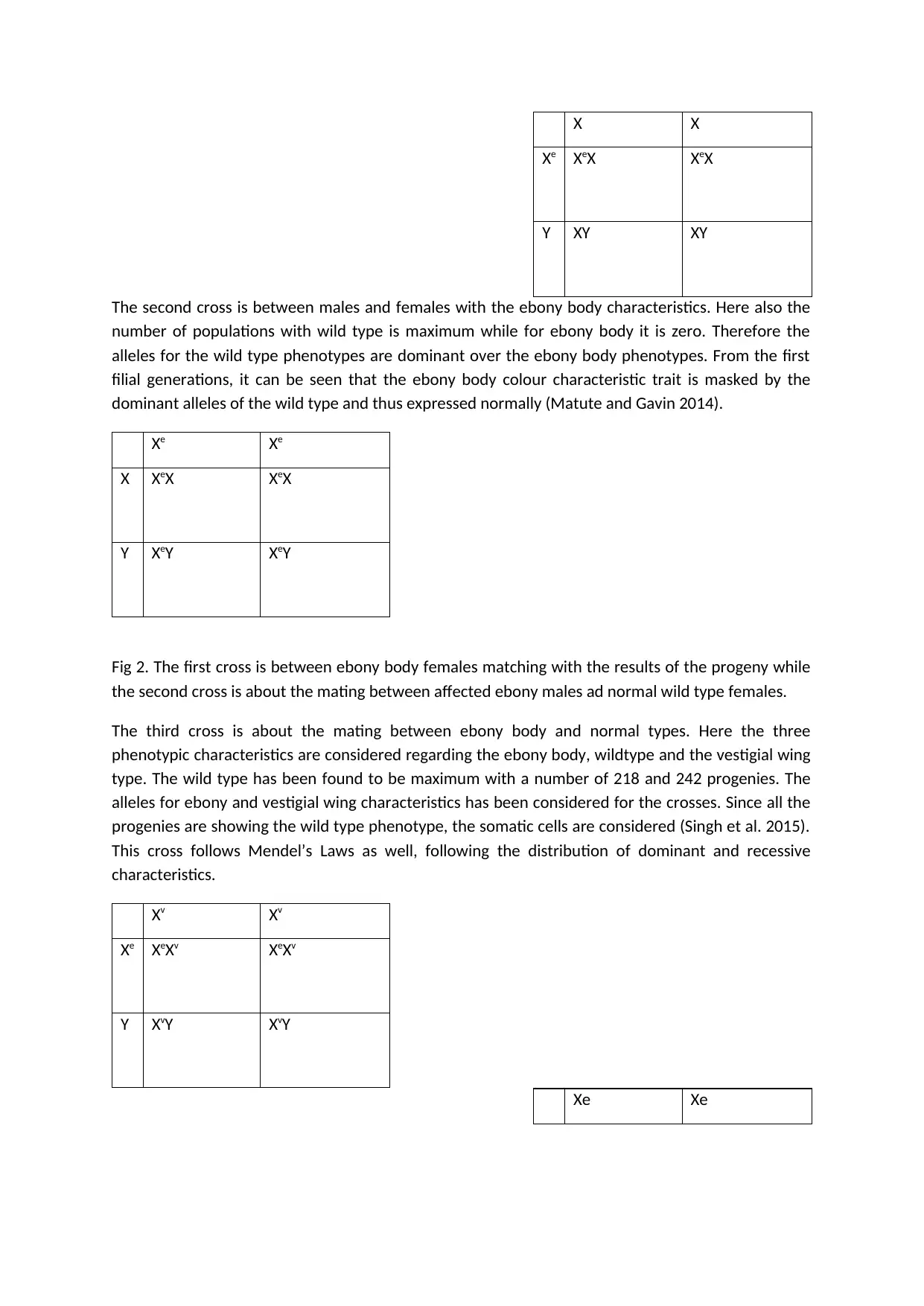
X X
Xe XeX XeX
Y XY XY
The second cross is between males and females with the ebony body characteristics. Here also the
number of populations with wild type is maximum while for ebony body it is zero. Therefore the
alleles for the wild type phenotypes are dominant over the ebony body phenotypes. From the first
filial generations, it can be seen that the ebony body colour characteristic trait is masked by the
dominant alleles of the wild type and thus expressed normally (Matute and Gavin 2014).
Xe Xe
X XeX XeX
Y XeY XeY
Fig 2. The first cross is between ebony body females matching with the results of the progeny while
the second cross is about the mating between affected ebony males ad normal wild type females.
The third cross is about the mating between ebony body and normal types. Here the three
phenotypic characteristics are considered regarding the ebony body, wildtype and the vestigial wing
type. The wild type has been found to be maximum with a number of 218 and 242 progenies. The
alleles for ebony and vestigial wing characteristics has been considered for the crosses. Since all the
progenies are showing the wild type phenotype, the somatic cells are considered (Singh et al. 2015).
This cross follows Mendel’s Laws as well, following the distribution of dominant and recessive
characteristics.
Xv Xv
Xe XeXv XeXv
Y XvY XvY
Xe Xe
Xe XeX XeX
Y XY XY
The second cross is between males and females with the ebony body characteristics. Here also the
number of populations with wild type is maximum while for ebony body it is zero. Therefore the
alleles for the wild type phenotypes are dominant over the ebony body phenotypes. From the first
filial generations, it can be seen that the ebony body colour characteristic trait is masked by the
dominant alleles of the wild type and thus expressed normally (Matute and Gavin 2014).
Xe Xe
X XeX XeX
Y XeY XeY
Fig 2. The first cross is between ebony body females matching with the results of the progeny while
the second cross is about the mating between affected ebony males ad normal wild type females.
The third cross is about the mating between ebony body and normal types. Here the three
phenotypic characteristics are considered regarding the ebony body, wildtype and the vestigial wing
type. The wild type has been found to be maximum with a number of 218 and 242 progenies. The
alleles for ebony and vestigial wing characteristics has been considered for the crosses. Since all the
progenies are showing the wild type phenotype, the somatic cells are considered (Singh et al. 2015).
This cross follows Mendel’s Laws as well, following the distribution of dominant and recessive
characteristics.
Xv Xv
Xe XeXv XeXv
Y XvY XvY
Xe Xe
⊘ This is a preview!⊘
Do you want full access?
Subscribe today to unlock all pages.

Trusted by 1+ million students worldwide
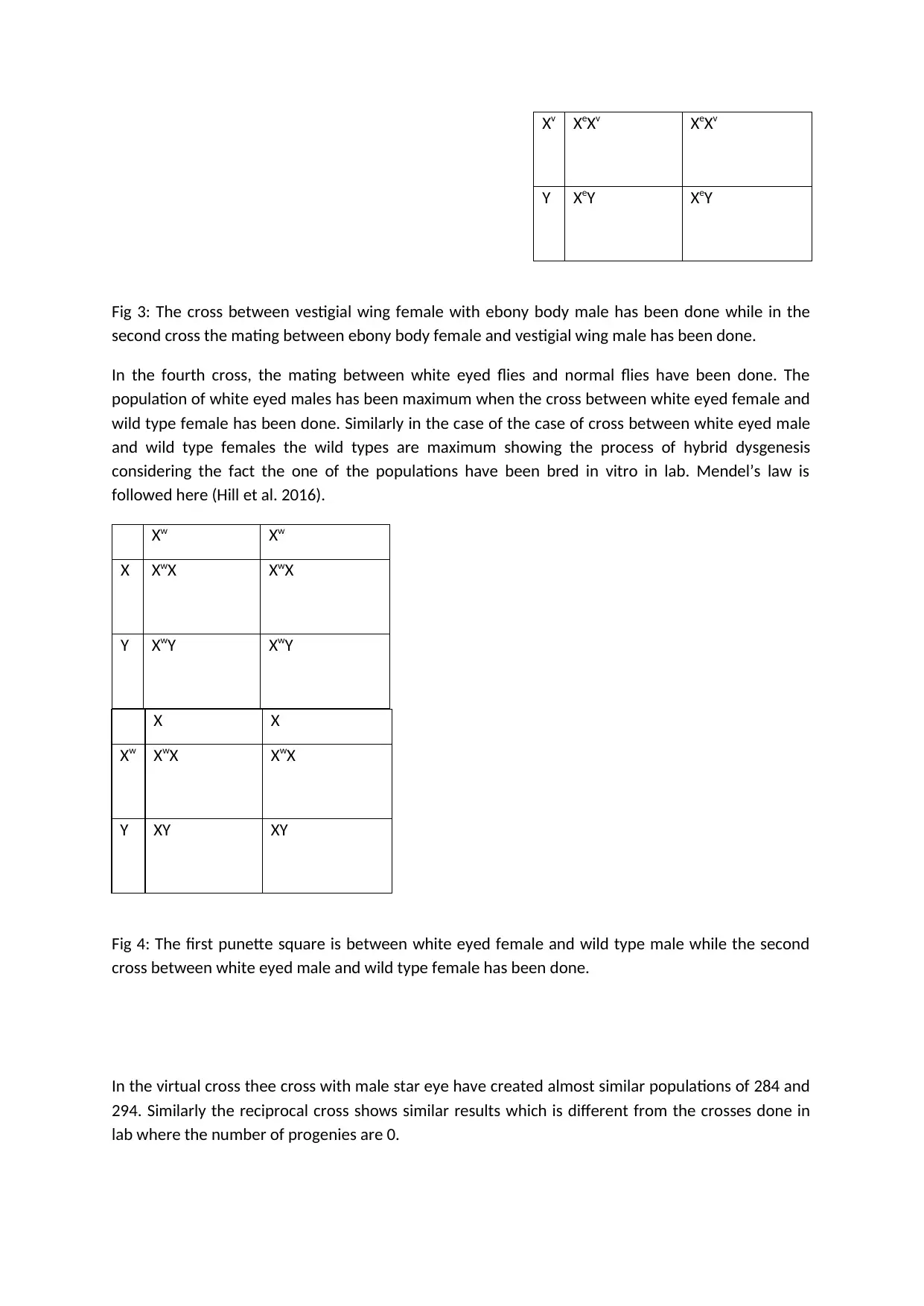
Xv XeXv XeXv
Y XeY XeY
Fig 3: The cross between vestigial wing female with ebony body male has been done while in the
second cross the mating between ebony body female and vestigial wing male has been done.
In the fourth cross, the mating between white eyed flies and normal flies have been done. The
population of white eyed males has been maximum when the cross between white eyed female and
wild type female has been done. Similarly in the case of the case of cross between white eyed male
and wild type females the wild types are maximum showing the process of hybrid dysgenesis
considering the fact the one of the populations have been bred in vitro in lab. Mendel’s law is
followed here (Hill et al. 2016).
Xw Xw
X XwX XwX
Y XwY XwY
X X
Xw XwX XwX
Y XY XY
Fig 4: The first punette square is between white eyed female and wild type male while the second
cross between white eyed male and wild type female has been done.
In the virtual cross thee cross with male star eye have created almost similar populations of 284 and
294. Similarly the reciprocal cross shows similar results which is different from the crosses done in
lab where the number of progenies are 0.
Y XeY XeY
Fig 3: The cross between vestigial wing female with ebony body male has been done while in the
second cross the mating between ebony body female and vestigial wing male has been done.
In the fourth cross, the mating between white eyed flies and normal flies have been done. The
population of white eyed males has been maximum when the cross between white eyed female and
wild type female has been done. Similarly in the case of the case of cross between white eyed male
and wild type females the wild types are maximum showing the process of hybrid dysgenesis
considering the fact the one of the populations have been bred in vitro in lab. Mendel’s law is
followed here (Hill et al. 2016).
Xw Xw
X XwX XwX
Y XwY XwY
X X
Xw XwX XwX
Y XY XY
Fig 4: The first punette square is between white eyed female and wild type male while the second
cross between white eyed male and wild type female has been done.
In the virtual cross thee cross with male star eye have created almost similar populations of 284 and
294. Similarly the reciprocal cross shows similar results which is different from the crosses done in
lab where the number of progenies are 0.
Paraphrase This Document
Need a fresh take? Get an instant paraphrase of this document with our AI Paraphraser
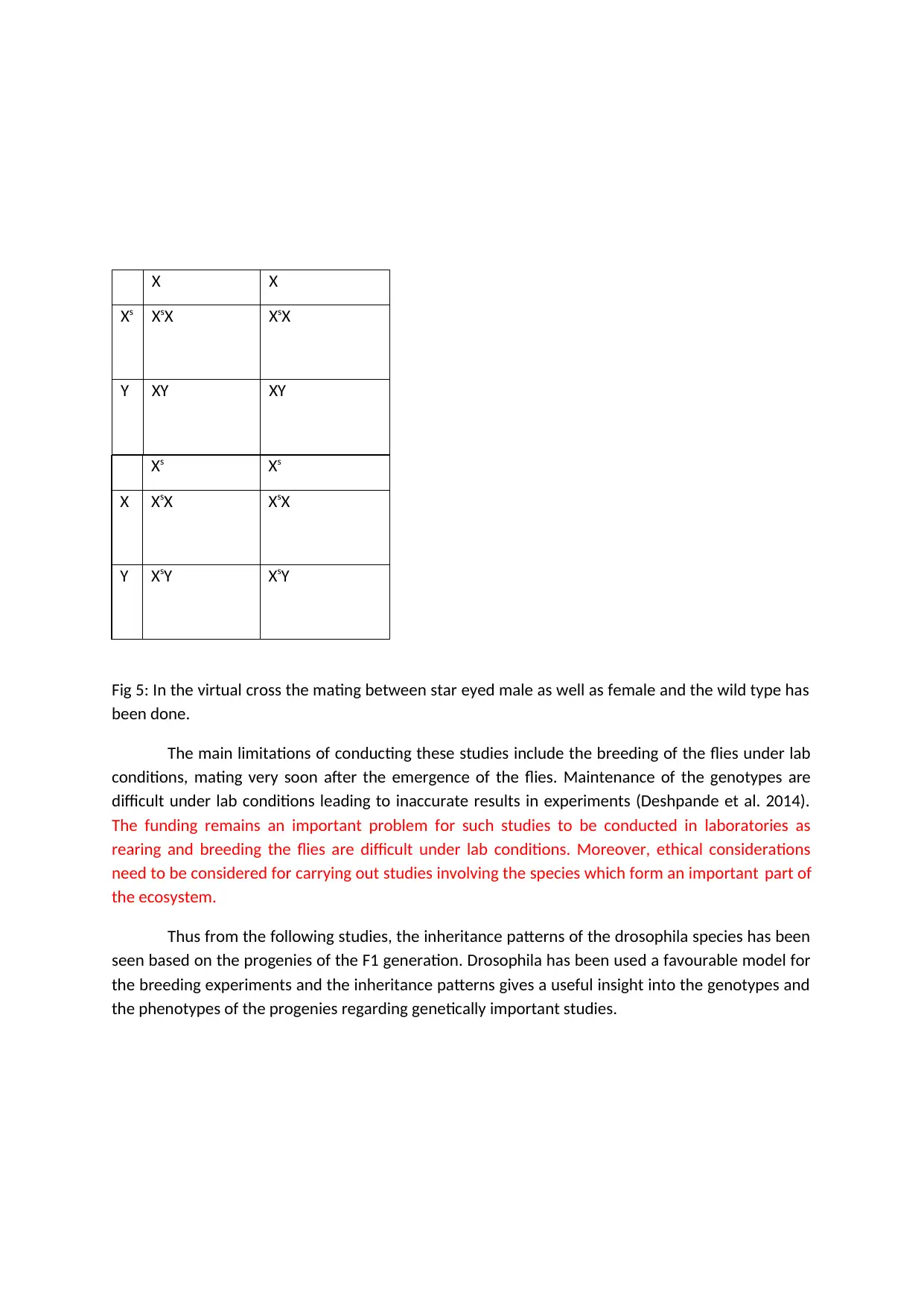
X X
Xs XsX XsX
Y XY XY
Xs Xs
X XsX XsX
Y XsY XsY
Fig 5: In the virtual cross the mating between star eyed male as well as female and the wild type has
been done.
The main limitations of conducting these studies include the breeding of the flies under lab
conditions, mating very soon after the emergence of the flies. Maintenance of the genotypes are
difficult under lab conditions leading to inaccurate results in experiments (Deshpande et al. 2014).
The funding remains an important problem for such studies to be conducted in laboratories as
rearing and breeding the flies are difficult under lab conditions. Moreover, ethical considerations
need to be considered for carrying out studies involving the species which form an important part of
the ecosystem.
Thus from the following studies, the inheritance patterns of the drosophila species has been
seen based on the progenies of the F1 generation. Drosophila has been used a favourable model for
the breeding experiments and the inheritance patterns gives a useful insight into the genotypes and
the phenotypes of the progenies regarding genetically important studies.
Xs XsX XsX
Y XY XY
Xs Xs
X XsX XsX
Y XsY XsY
Fig 5: In the virtual cross the mating between star eyed male as well as female and the wild type has
been done.
The main limitations of conducting these studies include the breeding of the flies under lab
conditions, mating very soon after the emergence of the flies. Maintenance of the genotypes are
difficult under lab conditions leading to inaccurate results in experiments (Deshpande et al. 2014).
The funding remains an important problem for such studies to be conducted in laboratories as
rearing and breeding the flies are difficult under lab conditions. Moreover, ethical considerations
need to be considered for carrying out studies involving the species which form an important part of
the ecosystem.
Thus from the following studies, the inheritance patterns of the drosophila species has been
seen based on the progenies of the F1 generation. Drosophila has been used a favourable model for
the breeding experiments and the inheritance patterns gives a useful insight into the genotypes and
the phenotypes of the progenies regarding genetically important studies.
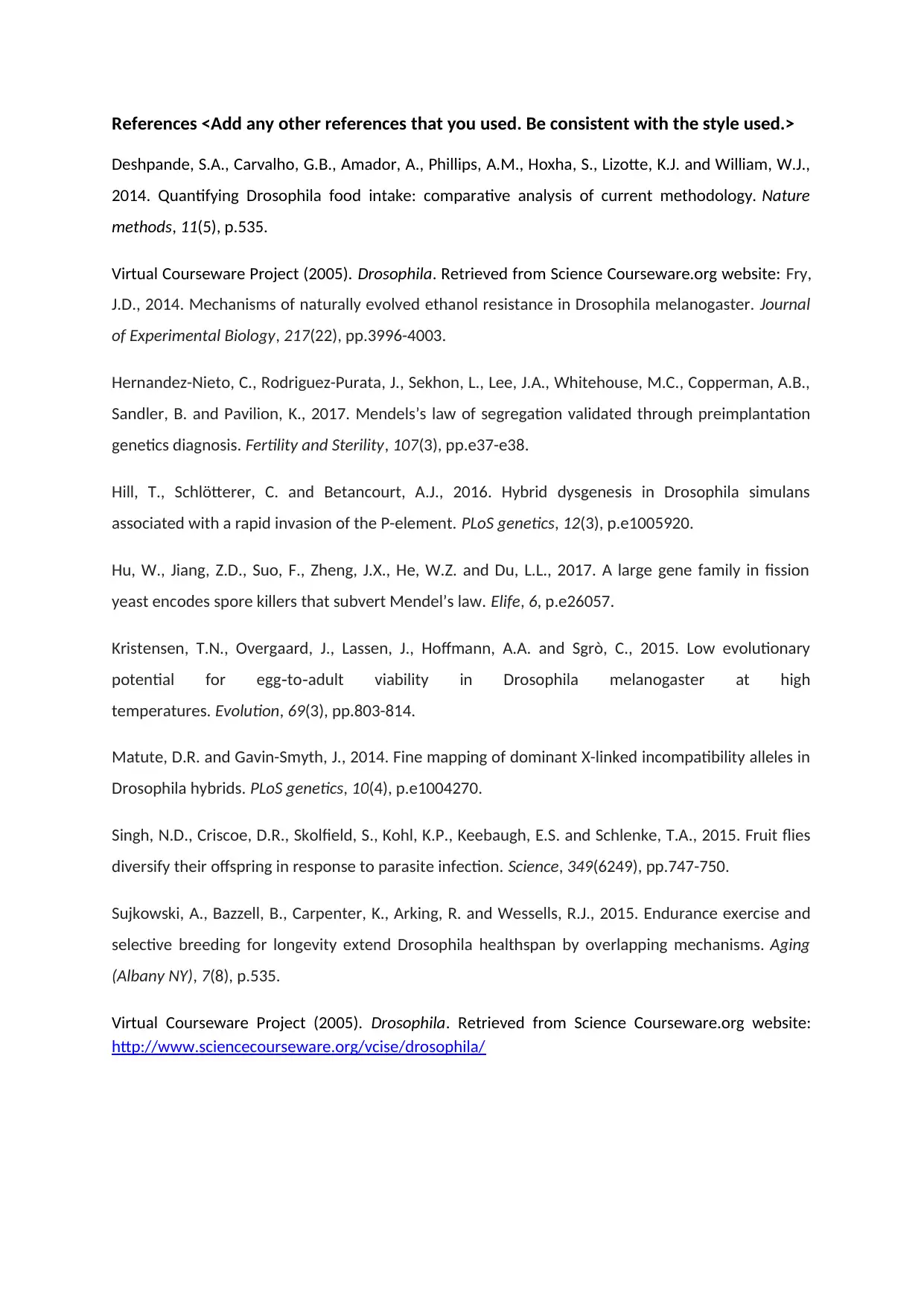
References <Add any other references that you used. Be consistent with the style used.>
Deshpande, S.A., Carvalho, G.B., Amador, A., Phillips, A.M., Hoxha, S., Lizotte, K.J. and William, W.J.,
2014. Quantifying Drosophila food intake: comparative analysis of current methodology. Nature
methods, 11(5), p.535.
Virtual Courseware Project (2005). Drosophila. Retrieved from Science Courseware.org website: Fry,
J.D., 2014. Mechanisms of naturally evolved ethanol resistance in Drosophila melanogaster. Journal
of Experimental Biology, 217(22), pp.3996-4003.
Hernandez-Nieto, C., Rodriguez-Purata, J., Sekhon, L., Lee, J.A., Whitehouse, M.C., Copperman, A.B.,
Sandler, B. and Pavilion, K., 2017. Mendels’s law of segregation validated through preimplantation
genetics diagnosis. Fertility and Sterility, 107(3), pp.e37-e38.
Hill, T., Schlötterer, C. and Betancourt, A.J., 2016. Hybrid dysgenesis in Drosophila simulans
associated with a rapid invasion of the P-element. PLoS genetics, 12(3), p.e1005920.
Hu, W., Jiang, Z.D., Suo, F., Zheng, J.X., He, W.Z. and Du, L.L., 2017. A large gene family in fission
yeast encodes spore killers that subvert Mendel’s law. Elife, 6, p.e26057.
Kristensen, T.N., Overgaard, J., Lassen, J., Hoffmann, A.A. and Sgrò, C., 2015. Low evolutionary
potential for egg to adult viability in Drosophila melanogaster at high‐ ‐
temperatures. Evolution, 69(3), pp.803-814.
Matute, D.R. and Gavin-Smyth, J., 2014. Fine mapping of dominant X-linked incompatibility alleles in
Drosophila hybrids. PLoS genetics, 10(4), p.e1004270.
Singh, N.D., Criscoe, D.R., Skolfield, S., Kohl, K.P., Keebaugh, E.S. and Schlenke, T.A., 2015. Fruit flies
diversify their offspring in response to parasite infection. Science, 349(6249), pp.747-750.
Sujkowski, A., Bazzell, B., Carpenter, K., Arking, R. and Wessells, R.J., 2015. Endurance exercise and
selective breeding for longevity extend Drosophila healthspan by overlapping mechanisms. Aging
(Albany NY), 7(8), p.535.
Virtual Courseware Project (2005). Drosophila. Retrieved from Science Courseware.org website:
http://www.sciencecourseware.org/vcise/drosophila/
Deshpande, S.A., Carvalho, G.B., Amador, A., Phillips, A.M., Hoxha, S., Lizotte, K.J. and William, W.J.,
2014. Quantifying Drosophila food intake: comparative analysis of current methodology. Nature
methods, 11(5), p.535.
Virtual Courseware Project (2005). Drosophila. Retrieved from Science Courseware.org website: Fry,
J.D., 2014. Mechanisms of naturally evolved ethanol resistance in Drosophila melanogaster. Journal
of Experimental Biology, 217(22), pp.3996-4003.
Hernandez-Nieto, C., Rodriguez-Purata, J., Sekhon, L., Lee, J.A., Whitehouse, M.C., Copperman, A.B.,
Sandler, B. and Pavilion, K., 2017. Mendels’s law of segregation validated through preimplantation
genetics diagnosis. Fertility and Sterility, 107(3), pp.e37-e38.
Hill, T., Schlötterer, C. and Betancourt, A.J., 2016. Hybrid dysgenesis in Drosophila simulans
associated with a rapid invasion of the P-element. PLoS genetics, 12(3), p.e1005920.
Hu, W., Jiang, Z.D., Suo, F., Zheng, J.X., He, W.Z. and Du, L.L., 2017. A large gene family in fission
yeast encodes spore killers that subvert Mendel’s law. Elife, 6, p.e26057.
Kristensen, T.N., Overgaard, J., Lassen, J., Hoffmann, A.A. and Sgrò, C., 2015. Low evolutionary
potential for egg to adult viability in Drosophila melanogaster at high‐ ‐
temperatures. Evolution, 69(3), pp.803-814.
Matute, D.R. and Gavin-Smyth, J., 2014. Fine mapping of dominant X-linked incompatibility alleles in
Drosophila hybrids. PLoS genetics, 10(4), p.e1004270.
Singh, N.D., Criscoe, D.R., Skolfield, S., Kohl, K.P., Keebaugh, E.S. and Schlenke, T.A., 2015. Fruit flies
diversify their offspring in response to parasite infection. Science, 349(6249), pp.747-750.
Sujkowski, A., Bazzell, B., Carpenter, K., Arking, R. and Wessells, R.J., 2015. Endurance exercise and
selective breeding for longevity extend Drosophila healthspan by overlapping mechanisms. Aging
(Albany NY), 7(8), p.535.
Virtual Courseware Project (2005). Drosophila. Retrieved from Science Courseware.org website:
http://www.sciencecourseware.org/vcise/drosophila/
⊘ This is a preview!⊘
Do you want full access?
Subscribe today to unlock all pages.

Trusted by 1+ million students worldwide
1 out of 12
Related Documents
Your All-in-One AI-Powered Toolkit for Academic Success.
+13062052269
info@desklib.com
Available 24*7 on WhatsApp / Email
![[object Object]](/_next/static/media/star-bottom.7253800d.svg)
Unlock your academic potential
Copyright © 2020–2025 A2Z Services. All Rights Reserved. Developed and managed by ZUCOL.





